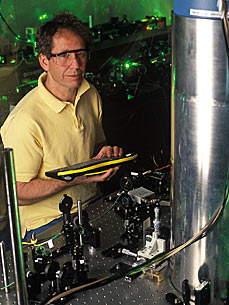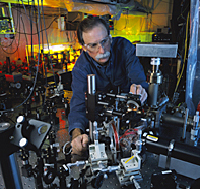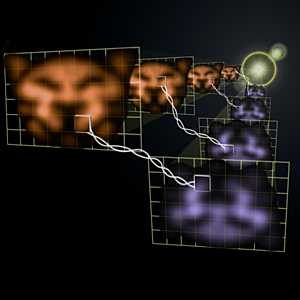Celebrating the 50th Anniversary of the Laser:
|
 |
| Photographs of individual frequencies, or "teeth" in an optical frequency comb. Credit:S. Diddams/NIST View high-resolution version |
http://www.nist.gov/public_affairs/newsfromnist_frequency_combs.cfm
 |
| NIST physicist Jim Bergquist with the mercury ion clock. @Geoffrey Wheeler For a high-resolution version of this photo contact inquiries@nist.gov |
2001—Timekeeping took a leap forward when NIST physicist Jim Bergquist used a very stable laser and a frequency comb specially modified by NIST colleague Scott Diddams and NIST guest researcher Thomas Udem to make what became the world’s best optical atomic clock, based on a single ion of mercury. Optical atomic clocks operate at much higher frequencies than microwave clocks such as NIST-F1. As of 2009, NIST’s experimental mercury clock is the most precise clock in the world: If it could be operated for that long, the clock would neither gain nor lose 1 second in more than 1 billion years. Even so, it remains to be seen which atom and optical clock design are chosen the next international standard for time and frequency. http://www.nist.gov/physlab/div847/mercury_atomic_clock.cfm
 |
| NIST physicist Deborah Jin. @Geoffrey WheelerFor a high-resolution version of this photo contact inquiries@nist.gov |
2004—NIST scientists, led by David Wineland, used lasers to demonstrate, concurrently with another research group in Austria, the first quantum “teleportation” of information stored in atoms, a technique that may be useful in quantum computers. Wineland helped launch the field of experimental quantum computing beginning in the mid-1990s.
 |
| NIST physicist David Wineland @Geoffrey Wheeler For a high-resolution version of this photo contact inquiries@nist.gov |
Through many pioneering experiments, this group was the first to successfully demonstrate the building blocks of a practical quantum computer—which, if one can be built, could solve certain problems that are intractable using today’s technology.
2004—NIST physicist John Kitching and colleagues used miniature lasers to demonstrate the first chip-scale atomic clock and first chip-scale atomic magnetometer, bringing atomic precision to a wide range of compact applications. The heart of these mini devices is about the size of a grain of rice. Several commercial versions of mini atomic clocks are in the works, and Kitching is now developing mini magnetometers for biomedical and security applications. http://www.nist.gov/public_affairs/releases/magnetometer.cfm
2004—NIST researchers Jack Stone and Alois Stejskal demonstrated a new instrument for measuring the refractive index of air. Using helium to self-calibrate a refractometer, the team was able to calculate the maximum uncertainty in length measurements introduced by the instrument itself. Uncertainty in the air refractive index is the limiting factor for realization of the meter using interferometry outside of a vacuum environment. (Length measurements in air require corrections based on precise knowledge of the air refractive index, and this sets the fundamental limitation for practical measurements.) The ability to correct for these errors provided a path toward future improvements in practical length measurements based on laser interferometry.
 |
| Quantum logic clock based on an aluminum ion. Credit: NIST |
2007—NIST researcher Kris Helmerson and colleagues from NIST and the University of Maryland made the first observation of a “persistent” current—a frictionless flow of particles—in an ultracold gas known as a Bose-Einstein condensate (BEC). To stir the gas, the researchers used a pair of laser beams that had been specially prepared to induce a kind of corkscrew motion, known as orbital angular momentum, to its constituent light particles (photons) and impart that motion to the atoms in the gas, causing them to swirl like a tornado. The technique could lead to the development of ultraprecise gyroscopes for navigation. http://www.nist.gov/public_affairs/techbeat/tb2007_1127.htm#bec
2008—NIST scientists demonstrated two different leading designs for experimental optical atomic clocks, which may one day supersede today’s time and frequency standards. Till Rosenband and colleagues published the first evaluation of a prototype “quantum logic clock” based on aluminum ion (electrically charged atom). This clock uses the logical reasoning process of quantum computers and is competitive with NIST’s world-leading experimental mercury ion clock. Meanwhile, Jun Ye and colleagues demonstrated a clock based on strontium atoms held in an optical lattice made of laser beams. This is the world’s most precise clock based on neutral atoms.
http://www.nist.gov/physlab/div847/logic_clock.cfm
http://www.nist.gov/public_affairs/clock/clock.html
 |
| In this photo montage of actual quantum images, two laser beams coming from the bright glare in the distance transmit images of cat-like face at two slightly different frequencies (represented by the orange and the purple colors). The twisted lines indicate that the seemingly random changes or fluctuations that occur over time in any part of the orange image are strongly interconnected or "entangled" with the fluctuations of the corresponding part in the purple image. Though false color has been added to the cats' faces, they are otherwise actual images obtained in the experiment. Credit: Vincent Boyer/JGI View high-resolution image |
For additional information about lasers and the 50th anniversary, see www.laserfest.org.
